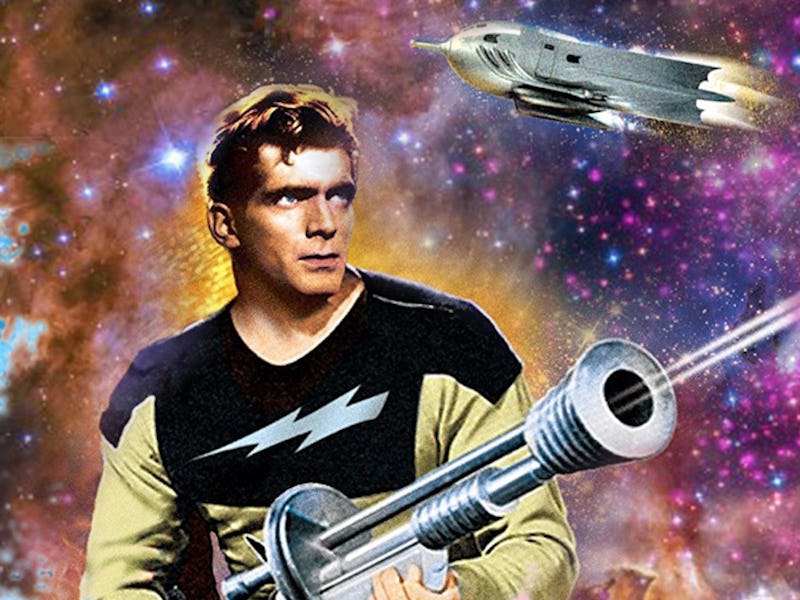How a Forgotten Sci-Fi Series Predicted the Future by Rebooting an Iconic Character
Changing origin stories is nothing new.

What if you threw out a character's entire backstory, changed the basic premise of their adventures, and didn’t bother to explain why? In modern fandoms, such radical reboots are often met with suspicion, even scorn. But in 1954, such a dramatic move was barely noticed.
While John Carter and Buck Rogers preceded Flash Gordon, the latter became the most famous of the vintage space heroes. George Lucas even wanted to do a Flash Gordon reboot movie in the 1970s, but couldn’t get the rights, forcing him to fall back on some little idea called Star Wars. But the version of Flash Lucas loved had its roots in the 1930s. A completely different version of Flash Gordon launched on October 1, 1954, only to be lost to time.
Lucas was heavily influenced by the 1930s and ‘40s serials starring Buster Crabbe as Flash. Many of their plot devices, and even their opening text crawls, influenced the aesthetic foundation of Star Wars. But while Lucas and other creators, like Star Trek’s Gene Roddenberry, thought of Crabbe when they thought of Gordon, another version of the character came after him.
In 1954, a small production company called DuMont Television did what Lucas later couldn’t, and secured the rights to an iconic character. This small West German firm also did something extremely bold, which would prove to be a model for various cult sci-fi shows to come: rely on syndicated distribution to find an audience. In a sense, although the show was much more juvenile than the sci-fi of the 1960s, the 1954 Flash Gordon was a precursor to Star Trek. This version even changed the setting to a distant future that scans as very Star Trek-y today.
In Alex Raymond’s early comic strips, Flash Gordon differed from Buck Rogers in that none of his adventures actually took place in the future. Instead, like Star-Lord in Guardians of the Galaxy, Flash is an everyman (a polo player in the original comic, and a football hero in the 1980 movie) who’s whisked away into space by the kooky Dr. Zarkov, with love interest Dale Arden accidentally brought along for the ride. In almost all adaptations, Flash is a contemporary man out of his element.
But not in the 1954 series. There, he isn’t a human from 20th-century Earth who finds himself traveling to strange new worlds. Instead, Flash (Steve Holland) lives in the year 3203 and works for the Galactic Bureau of Investigation. His origin story doesn’t suggest anything about him or Dale Arden (Irene Champlin) being from a past Earth. But for 39 episodes, Flash and the crew of The Sky Flash, including a non-mad Dr. Zarkov, were sent on missions to investigate space mysteries and interstellar problems.
The future can be a dangerous place.
Structurally, this version of Flash Gordon predicts the planet-of-the-week format that Doctor Who and Star Trek would follow in 1964 and 1966. Both of those shows, however, courted more adult audiences, whereas Flash Gordon presented black-and-white morality tales to younger viewers. Androids standing in for Soviets made for a typical episode (incidentally, the writer of “Flash Gordon and the Return of the Androids,” Bruce Geller, would create Mission: Impossible in 1966).
That said, Dale is much more independent than her counterpart in the 1930s or the 1980 film, which is also reminiscent of the egalitarian tendencies of Star Trek and future space-based-crew-on-a-mission sci-fi shows. While the show carried Flash’s name, it wasn’t his series in the same way the Buster Crabbe serials were. This was an ensemble series, where you tuned in to see what familiar characters were doing week-to-week. And believe it or not, the idea of recurring characters in pre-1960s sci-fi TV was rarer than you’d think.
Flash Gordon’s family-friendly format made it popular in syndicated markets, but not widely remembered. The show wasn’t true to the original character concept, but by ditching the overt sexism of its predecessor to focus on the weekly sci-fi story at hand, it forged new territory for the flexibility of sci-fi franchises in general. When Flash was rebooted again in 1980, or referenced by Lucas in 1977, the more regressive, pulpy versions of the character re-emerged, leaving this strange, quieter Flash eclipsed by the bigger heroes who emerged in his wake.